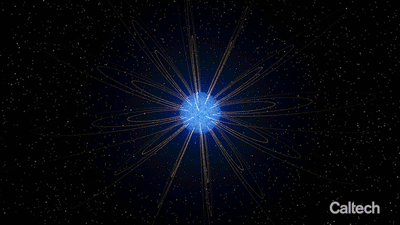Two-Faced Star Exposed: Discovery of Doctor Przemysław Mróz

20 07 2023
Category: Achievements, Astronomy, Discoveries, Research network “Early Universe”
An international team of astronomers has announced the discovery of an unusual white dwarf star that is made of hydrogen on one side and helium on the other. They reported their findings in the latest issue of Nature. Dr Przemysław Mróz, employed within the Early Universe research network, is a co-author of the study.
The object discovered by the scientists is a white dwarf, the scalding remains of a small-mass star such as the Sun. As stars age and burn out the fuel inside them, they expand to enormous sizes (up to several hundred times larger than the Sun today), becoming a so-called red giant. At the final stage of its life, it discards its outer gaseous envelope. What is left behind is a hot, dense nucleus which consists of the products of past thermonuclear reactions, usually carbon and oxygen. The nucleus is covered by a thin layer of helium or hydrogen. This is what a white dwarf is.
White dwarfs have masses close to those of the Sun, but are up to a hundred times smaller and a million times denser than it. One teaspoon of matter building a white dwarf can weigh as much as a passenger car.
A team including Dr Przemysław Mróz described the discovery of a white dwarf, half of which is composed of hydrogen and the other half is made up of helium. The object was named Janus after the two-faced Roman god of transition.
The object was initially discovered by the Zwicky Transient Facility (ZTF), an instrument that scans the skies every night from Palomar Observatory in California. Dr Przemyslaw Mróz was, among other things, responsible for taking brightness measurements of more than 1 billion stars observed by the ZTF project, which led to the discovery of this unusual object. As he puts it: “The star was distinguished by large changes in brightness, repeated every 15 minutes. This is as long as one rotation of its axis takes.”
Subsequent observations made with the W. M. Keck Observatory atop Maunakea in Hawaii revealed the double-faced nature of the star. The team used an instrument called a spectrometer to spread the light of the white dwarf into a rainbow of wavelengths that contain chemical fingerprints. The data revealed the presence of only hydrogen on one side of the object and only helium on the other side.
The atmospheres of some white dwarfs are believed to undergo a transformation from all-hydrogen to all-helium. Due to their high density, and therefore strong gravity, heavy elements sink to the centre of the white dwarf. Hydrogen is the lightest of all the elements and floats to the surface. However, it is thought that as the white dwarf cools down over time, mixing of hydrogen and helium layers on the star’s surface should occur. Janus is probably the first object in which this phenomenon has been observed directly.
However, the reason for such significant differences in surface chemistry is not known. Scientists speculate that the magnetic field may be the key to explaining them. “Magnetic fields around cosmic bodies tend to be asymmetric, or stronger on one side,” says Ilaria Caiazzo, a postdoctoral scholar at the California Institute of Technology who leads a new study. “Magnetic fields can prevent the mixing of materials. So, if the magnetic field is stronger on one side, then that side would have less mixing and thus more hydrogen.”
Another theory proposed by the team to explain the two faces also depends on magnetic fields. But in this scenario, the fields are thought to change the pressure and density of atmospheric gases. “The magnetic fields may lead to lower gas pressures in the atmosphere, and this may allow a hydrogen ‘ocean’ to form where the magnetic fields are strongest”, says co-author James Fuller, professor of theoretical astrophysics at Caltech.
To help solve the mystery, the team hopes to find more Janus-like white dwarfs in the data from current and future large sky surveys.
Dr Przemysław Mróz is employed within the “Early Universe” research network, which is one of the actions planned under Priority Research Area II. It aims to support, integrate, intensify, and initiate research in subatomic physics, astronomy, geochemistry, and mineralogy at the University of Warsaw, with particular emphasis on areas related to understanding early stages in the evolution of the Universe (read more»).
Illustration: Artist’s vision of the magnetic field around a white dwarf. Source: Caltech.
Details of the paper
Caiazzo, K. Burdge, L. Ferrario, P. Mróz, et al., „A rotating white dwarf shows different compositions on its opposite faces”, Nature, DOI: 10.1038/s41586-023-06171-9.

